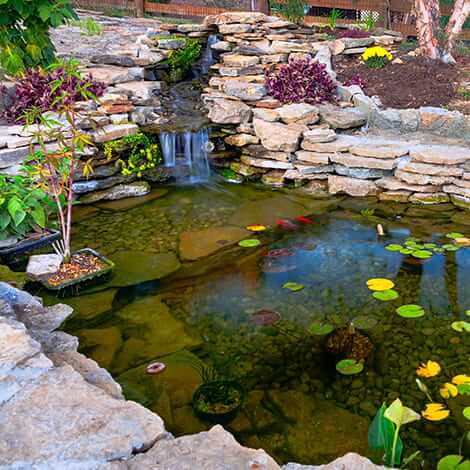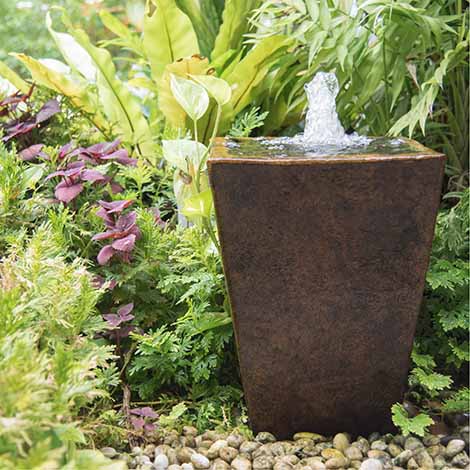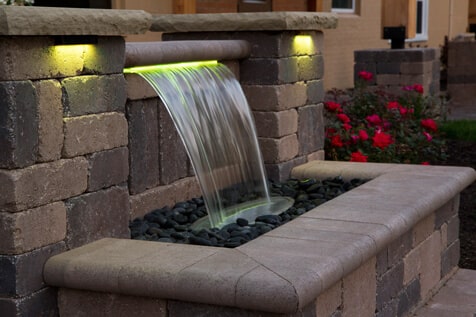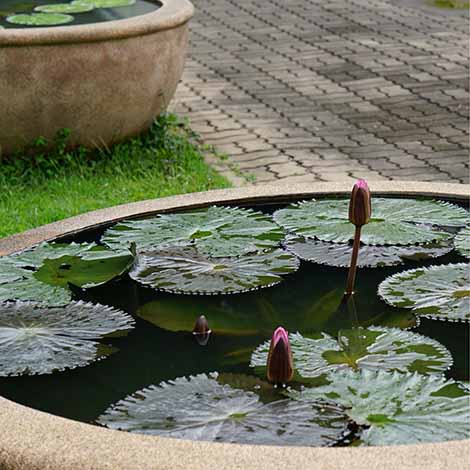Water gardening has grown from the formal koi pond into all types and shapes of water features. Moving water masks road noise and gives you a sense of privacy. Whether you live in an urban courtyard or a suburban neighborhood, rocks, fountains, statuary, waterfalls, and streams can be combined with a pond to add visual interest or become the main feature. They create functional outdoor living areas where you can enjoy the tranquility and beauty ponds provide while boosting your home's value and curb appeal.
Look at the different types of water features and choose what's best for you. It will be well worth your investment. Creating a water feature is a fun and exciting process consisting of endless designs limited only by your imagination. With so many types, anyone can add a water feature to their backyard landscape.
Koi Pond
Koi ponds are hyper-focused on the koi fish themselves. Koi pond owners plan and design their ponds to raise an abundance of koi for showing in fish clubs, for koi competitions, for selling koi, or simply as an enjoyable hobby.
These ponds typically rely on heavy-duty filtration systems and UV sterilizers. They are much more complex than the pond skimmers, pressurized filters, and waterfall boxes water gardeners use. Koi ponds often utilize bottom drains and increased water flow to create ideal breeding conditions.
So, how deep should a koi pond be? One distinguishing factor of a typical koi pond is its depth, usually four feet deep or more. The design is often more formal, free of anything interfering with the koi, such as plant shelves or other fish like goldfish. Koi ponds commonly include floating plants for filtration, aesthetic appeal, and to discourage predators while also increasing the usable area for fish to roam and grow.
Water Garden
Water gardens, adorned with spitters, plants, lighting, and other outdoor decor, have become a popular backyard addition. They can contain all types of fish, with goldfish and koi being the most popular. Water gardens are typically less than two feet deep and have plant shelves around the outside perimeter to hold various aquatic habitats and visual stimulation.
- Preformed Pond Liners: Creating a water garden with a preformed pond liner is a typical beginner pond. It is usually purchased as a beginner "Do It Yourself" kit at home improvement stores. To install, dig a hole in the ground with the same layout, drop the preformed pond liner into the hole, and fill it with water.
You can easily add a small all-in-one pond filtration system to create a clean environment for a few colorful fish and some aquatic plants. This pond type is where many water garden owners begin before upgrading to a more custom pond design. - EPDM Rubber Pond Liners: Another "Do It Yourself" option is using EPDM rubber pond liners included in many pond kits or elaborate professional installations. The flexibility of the rubber pond liners allows more creativity when constructing the shape of a pond. Rubber-lined ponds tend to be larger and are often used to build streams decorated with rocks and waterfalls to create a more natural look in the surrounding environment.
Since the material is non-toxic and safe for aquatic life, EPM rubber liners are popular among water gardens that want to add a variety of colorful koi or goldfish. This type of water garden utilizes waterfall boxes, pressurized filters, and bog plants to provide circulation and filtration.
Pondless Waterfall
Pondless waterfall installations make an excellent choice for homeowners who prioritize safety, have limited space to work with, or lead busy lives and don't have the time to maintain a fish pond.
Pondless features use a catch basin filled with rocks that will allow the water to pass through so you can enjoy a waterfall without an open body of water. Adding vibrant bog plants, multi-tiered waterfalls, and natural stone will create a natural appearance.
Disappearing Fountain
This fountain feature also uses a catch basin to re-circulate water; instead of a waterfall, a decorative fountain, pot, or rock can function as the focal point of water. This feature requires little room, provides the sound of running water, and is easy to maintain.
Waterwalls & Spouts
Waterwalls and formal wall spouts are growing in popularity as an elegant way to add the sight and sound of water to vertical surfaces. They are great for smaller outdoor areas or even an indoor space. Waterwall spillways are designed specially to guide the water down the wall for a gentle trickle. Spouts are an easy way to add water to a formal retaining wall.
Container Water Garden
The smallest of water features, this type of "pond" can use any decorative pot. Place a few potted aquatic plants, maybe a fish or two, and you are done. Great for decks and patios!
Plan Ahead
When planning to build your water feature, set aside a weekend, preferably one without rain, of course. Just remember it is far easier (and cheaper) to work with your pen and paper in the planning stages than once you start building your water feature. Planning helps prevent any unwanted surprises.
Keeping a water feature will be a learning experience, but you can contact our experts every step of the way. As you learn more about the technical aspects of maintaining water quality, keeping koi or aquatic plants, and managing the pump and filter, your pond will look better and better and bring you more satisfaction as a hobbyist.
Of course, these examples only scratch the surface of a decorative pond or water feature's benefits to your yard. You don't have to start with a big in-ground pond, but once you hear the sound of the water, see the wildlife it brings, and feel your stress melt away, you'll be hooked!
Read More Related Articles
Small Pond Waterfall Ideas
How to Build a Pond
Water Gardens 101
Pondless Feature Maintenance
Last Updated: October 24, 2023




